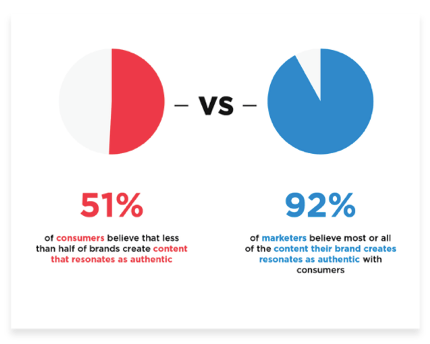
Everybody loves a great story. Storytelling is a human pastime, something we’ve been doing for thousands of years.
Those same foundational elements of a moving story apply to content marketing.
With brand storytelling, you can create an emotional connection with your audience.
So, how do you effectively implement and scale brand storytelling into your content strategy? We’re going to show the steps to take to do just that.
Quick Takeaways
- Brand storytelling uses narrative formats to create emotional connections with audiences.
- Using storytelling in your content marketing allows you to build trust with a buyer.
- Following a step-by-step plan can jumpstart your storytelling initiatives.
What Is Brand Storytelling?
First, let’s define what brand storytelling means. It’s “using a narrative to connect your brand to customers, with a focus on linking what you stand for to the values you share with your customers.”
To break it down further, here are some more insights into the philosophy:
- The narrative describes storytelling elements, including characters, setting, plot (with a beginning, middle, and end), theme, conflict with climax, and resolution. When content takes this shape, it engrosses the reader and boosts recall. As far as characters go, your audience is the hero, not your brand.
- The “what you stand for” element is your brand’s heart. It’s not your product or service. It’s your “why.” Why you do what you do, outside of generating revenue.
- Values are the attributes of your brand. These aren’t abstract aspirations but the embodiment of your culture.
With all these elements, you’ll be able to grab the buyer’s attention and create deeper connections.
Why Use Storytelling in Content Marketing?
Employing storytelling can be very potent. It’s actually part science, as human brains react to narratives in a more complex way than just reading a list of statistics. Check out the video below on a host of neurological findings around storytelling in a TEDx talk by presentation expert David JP Phillips.
Beyond the science aspect, there are many advantages of storytelling.
It attracts the “right” customers: Remember, your audience is the hero of the story. For those that identify with this, it equates to finding more engaged customers. They are likely to stay loyal and become advocates.
It makes retention less challenging: After someone becomes a customer, the journey isn’t over. If the foundation of your relationship is emotional, they are less likely to defect to a competitor.
It promotes authenticity: Customers are all in for brands to be genuine and transparent. A study found that 90% of buyers believe authenticity is important. However, only 51 percent believe brands are accomplishing this, which means there’s more work and opportunity ahead.

With all the advantages of storytelling, now it’s time to put the strategy in motion. Let’s look at the steps to effective brand storytelling.
7 Steps for Brand Storytelling
The steps to telling great stories take their cues from the Hero’s Journey. It’s the template for storytelling made famous by Joseph Campbell in his book The Hero with a Thousand Faces.

The Hero’s Journey is a formula, but it’s not one you must adhere to precisely. There’s always room for adjustment and creativity, and the stories you’re writing aren’t science fiction novels. Instead, what’s most important is getting these seven steps right.
Step One: What Can You Turn into a Story?
Writing great stories for your brand starts with determining what you can turn into a story. What will work in a narrative format? Here are some tips for ideation:
- Are there particular challenges or situations your customers are facing that would make a good story?
- Case studies and customer stories are some of the easiest content formats to turn into stories. However, many brands don’t add much personality or story elements to these, so it’s something to consider.
- Gathering insights directly from customers through surveys, feedback, or what you hear from sales or customer service can be good fodder for stories.
Step Two: Define Your Hero

Every story begins with the hero. You already know that your customer is the hero, but you need to flesh that out to an actual character with motivations, feelings, challenges, and needs. In developing the hero, it should mirror the traits of your buyer personas.
You’re setting up who this person is and what makes them tick. If you do this well, customers will see themselves in the story. When someone identifies with a character in a story, it becomes an even more powerful device.
Step Three: Develop the Hero’s Goal or Journey
Every hero needs a goal or journey. The first question is, “What does your character want?” The answer can be simple or complex. It depends on the context.
For example, if you’re a company that sells software for big data analysis, then your hero’s journey is to understand their data and be able to do something with it. Now, this probably doesn’t sound like a page-turner, but it could be with the right tone and energy.
The goal will run through the story and be its foundation. It sets up the plot with its beginning. How will the hero solve their problem?
Step Four: Inject Conflict
Stories always have conflict; it’s what makes them exciting. Taking the example above, the hero faces many conflicts to achieving the goals:
There’s too much data.
I don’t have a huge budget.
I can’t get buy-in from leadership.
Other solutions are too complex.
Those are all real-life conflicts you can frame in your narrative, showing the hero roaming through their path, incurring so many challenges to accomplish their crucial goals.
Step Five: Add Some Drama
The conflict is the beginning of the drama. Now is the time to add elements that make it exciting and entertaining for the reader. You could include interactions with others that are causing the conflict and create suspense and intrigue. You can take this more seriously or lighten it up with humor.
Step Six: Let Your Hero Experience Change
In any great book, the hero goes through things that bring about an evolution. Your hero should do the same thing. Maybe they feel backed into a corner with the problem. They have frustrations or anger.
The hero should change in the story as they get closer to their goal. Their change, along with other characters, is key to making it compelling. The transformation of characters indicates they learned new things along the way, which makes their mission attainable.
Step Seven: Give It an Ending
Your hero has made it through the journey. They faced challenges, conflict, and drama. However, they finally found what they desired. They did so with the help of your brand. This isn’t the time to turn the story into a commercial. Rather, it’s an opportunity to highlight how your “why” aligns with what they need to succeed. It’s about how your brand makes the hero’s goal achievable.
Final Tips of Brand Storytelling
Following these steps can help you become a great brand storyteller. Here are a few more tips:
- Stay true to your brand’s voice.
- Keep it simple; being overly elaborate can impact recall.
- Maintain a good pace to the story; don’t go off on tangents.
- Introduce emotion whenever possible.
- Remain authentic and genuine.
Ready to Create Stories for Your Audience?
Storytelling is one aspect of the content you create. The stories have to keep coming to be effective at content marketing. That can be challenging for some companies. We can help!
If you are ready to get more traffic to your site with authentic, personalized content published consistently, check out our Content Builder Service.
Set up a quick consultation, and I’ll send you a free PDF version of my books. Get started today–and generate more traffic and leads for your business.
The post 7 Steps to Effective Brand Storytelling appeared first on Marketing Insider Group.
7 Steps to Effective Brand Storytelling posted first on http://rssmix.com/u/11592782/rss.xml
No comments:
Post a Comment